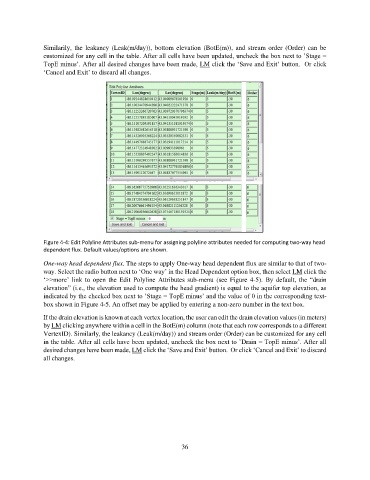Page 36 - manual_V5_11_9_2018_Html5
P. 36
Similarily, the leakancy (Leak(m/day)), bottom elevation (BotE(m)), and stream order (Order) can be
customized for any cell in the table. After all cells have been updated, uncheck the box next to ’Stage =
TopE minus’. After all desired changes have been made, LM click the ‘Save and Exit’ button. Or click
‘Cancel and Exit’ to discard all changes.
Figure 4-4: Edit Polyline Attributes sub-menu for assigning polyline attributes needed for computing two-way head
dependent flux. Default values/options are shown.
One-way head dependent flux. The steps to apply One-way head dependent flux are similar to that of two-
way. Select the radio button next to ‘One way’ in the Head Dependent option box, then select LM click the
‘>>more’ link to open the Edit Polyline Attributes sub-menu (see Figure 4-5). By default, the “drain
elevation” (i.e., the elevation used to compute the head gradient) is equal to the aquifer top elevation, as
indicated by the checked box next to ’Stage = TopE minus’ and the value of 0 in the corresponding text-
box shown in Figure 4-5. An offset may be applied by entering a non-zero number in the text box.
If the drain elevation is known at each vertex location, the user can edit the drain elevation values (in meters)
by LM clicking anywhere within a cell in the BotE(m) column (note that each row corresponds to a different
VertexID). Similarly, the leakancy (Leak(m/day)) and stream order (Order) can be customized for any cell
in the table. After all cells have been updated, uncheck the box next to ’Drain = TopE minus’. After all
desired changes have been made, LM click the ‘Save and Exit’ button. Or click ‘Cancel and Exit’ to discard
all changes.
36

